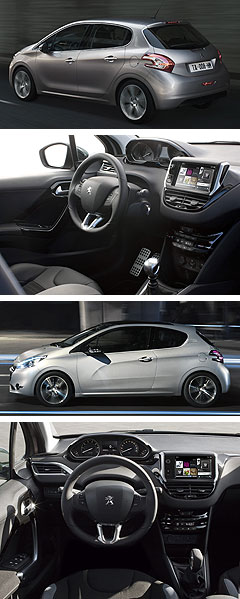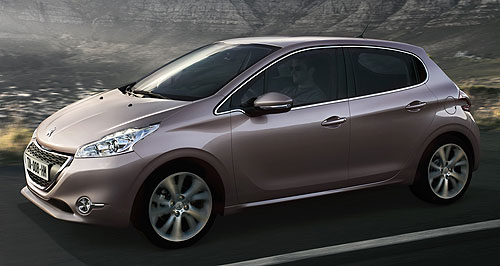Make / Model Search
Future models - Peugeot - 208 - 1.2Peugeot 208’s terrific tripleThree is a magic number: Peugeot's three-cylinder petrol engine delivers 60kW of power and 118Nm of torque. Lion-hearted three-pot propels petite Peugeot 208 into class contention20 Apr 2012 By BYRON MATHIOUDAKIS in PORTUGAL PEUGEOT’S petite premium-niche 208 supermini will include its segment’s first three-cylinder engine alternative as the company embraces downsizing like never before. Known as the Active 1.2 VTi, the petrol-powered base model is expected to maintain the preceding 207 XR 1.4’s $18,990 price when sales kick off in Australia from late September. Four years in the making and devised from the onset for the A9-series 208, the EB-series engine family eventually will include turbo-charged as well as naturally aspirated eco versions. A blank-sheet design, the in-line three-cylinder powerplant will feature in a range of Peugeots and Citroens, including the all-new 301 small car due next year, and may even find its way in larger models such as the 408 and 508. The EB should not be confused with the Toyota-supplied 1.0-litre three-cylinder that has powered the Peugeot 107/Citroen C1/Toyota Aygo triplets since 2005. Australian buyers will have a chance to sample the EB in 1.2-litre VTi guise, delivering 60kW of power at 5750rpm and 118Nm of torque at 2750rpm. It is capable of reaching 175km/h, returning 4.5 litres per 100 kilometres in the EU combined fuel consumption run, and emitting just 104 grams per kilometre of carbon dioxide emissions.  In contrast, the outgoing 207 XR 1.4L’s four-cylinder petrol unit pumps out more of everything … 70kW and 136Nm as well as 6.0L/100km and 139g/km. But is it a case of less is more? European 208s are fitted with the even smaller 1.0-litre member of the EB three-cylinder VTi family, down 10kW, 33Nm, 10km/h, 0.2L/100km and 5g/km, and so unlikely to make it Down Under any time soon. In contrast, the outgoing 207 XR 1.4L’s four-cylinder petrol unit pumps out more of everything … 70kW and 136Nm as well as 6.0L/100km and 139g/km. But is it a case of less is more? European 208s are fitted with the even smaller 1.0-litre member of the EB three-cylinder VTi family, down 10kW, 33Nm, 10km/h, 0.2L/100km and 5g/km, and so unlikely to make it Down Under any time soon.Not surprisingly, both models tip the scales at just 975kg – making the EB duo not just the featherweights of the 208 range, but also just 1kg heavier than the 1998 206 which featured a fraction of their safety and equipment. Meanwhile, the 207 XR 1.4 ate all the pies at 1124kg. Or, put another way, its power-to-weight ratio is 17.5kg per kilowatt compared to the 1.2L’s 16.25kg/kW. A company spokesman told GoAuto that achieving a strong wad of low-down torque for big-car driveability as well as low consumption preoccupied Peugeot’s engineers during EB development. To aid Peugeot’s pursuit of maximising fuel efficiency, the company has developed an optional five-speed automated manual in lieu of the standard five-speed manual transmission. Similar engine and gearbox combinations will be available in the upcoming (but next-size down) Volkswagen Up ASG due out at the same time from about $15,000, and 2013 Skoda Citigo, while the $11,790 Suzuki Alto GL and $12,990 Nissan Micra ST offer automatic transmissions of the less efficient torque-converter four-speed varieties. Recently we raved about the Citigo manual but expressed profound disappointment at the clunky automated transmission in an Up ASG. Does the 208 EGC suffer the same fate? Frustratingly we cannot say, for at the 208 launch in Portugal, the only three-pot models available for short test drives were a trio of pre-production manual prototypes. However, what we can tell you is that the 1.2L with five speeds and a clutch turned out to be quite the eye opener. With a lighter front end, instant low-rev torque and a propensity to rev freely to the 6100rpm red line, the three-cylinder supermini eclipsed our expectations of how much fun this engine can be. While we confess to being fans of the in-line three, most versions we’ve sampled, such as the Micra, Toyota iQ and Skoda Citigo, have weighed below 900kg. So we harboured doubts as to whether the Peugeot powerplant could handle a 975kg 208 1.2L plus two adult males. But we ought to not have worried. Step-off acceleration is brisk, with a steady stream of torque to make the little Peugeot feel willing and able on the open road, as well as in tight city streets. Plus, the manual gearshift quality is a cut above the other five-speed manual 208 variants we also sampled, so rowing the three-pot along is no chore. More steering feedback is another 1.2L bonus, with precious more feel available to the driver than in other variants. Wearing (optional) 195/55 R16 eco rubber, the limits of the front-end tyre grip ran out well before the chassis’, but all it took was a lift off of the accelerator to kick the hatch back into line. We have not had this much fun in a new baby Peugeot in years. On dryer roads it is clear that you can drive the least powerful 208 flat-out and rely on the agile and responsive chassis to see you through. We were enjoying ourselves so much on the damp and twisty roads outside of Lisbon that we didn’t want to give it back. And speaking of back, an absorbent ride quality came as an unexpected bonus. Remarkably, the 1.2-litre’s refinement levels are also better than we had anticipated, with just a little bit of that offbeat thrum entering inside. So, perhaps unbelievably, considering that this is the base car we’re talking about, there is something of the spirit of the old 205 in the 1.2L. Underlined by the pert and pretty styling on the outside, as well as the simple yet fresh cabin ergonomics going on inside, the base 208 evokes yesterday as well as tomorrow. A good example of this is the interior. While a modern rethink of the driver’s relationship with the car sees a smaller steering wheel, higher-placed and further set-back instruments, and advanced touch-screen functionality, the dash and lower centre console area are meant to remind us of the 205’s, according to one senior cabin designer. Whether it also has to do with revving the fiery little engine right out to exploit a chassis that can clearly handle much more power, sharp handling that is the upshot of a big weight drop, playful chassis, promise of cheap fun, or even the sound and feel of that fizzy triple working away up ahead, we’re smitten. No, we’re not quite claiming this is a return to Peugeot’s 1980s and ‘90s glory days – and indeed the larger 1.6L models have cons as well as pros – the 1.2L might just be the 208 that turns it all around again at last. We’ve heard about small things punching above their weight … well, it’s the perfect analogy for this terrific little Peugeot triple.  Read more19th of April 2012  First Drive: Peugeot 208 is no featherweightDownsized 208 Euro supermini aims to elevate Peugeot to the top of the class19th of February 2012  Geneva show: Peugeot primes 208 GTi hot hatchPeugeot reveals hot GTi and luxurious XY versions of its 207 successor, the 208All future models208 pricing
Motor industry news |
Click to sharePeugeot modelsResearch Peugeot All future models208 pricing
Motor industry news |



 Alfa Romeo
Alfa Romeo Abarth
Abarth Audi
Audi Aston Martin
Aston Martin BMW
BMW Bentley
Bentley Ferrari
Ferrari Chevrolet
Chevrolet Ford
Ford Fiat
Fiat GWM
GWM Foton
Foton Hyundai
Hyundai Honda
Honda Jaguar
Jaguar Isuzu
Isuzu Kia
Kia Jeep
Jeep Land Rover
Land Rover Lamborghini
Lamborghini Maserati
Maserati Lexus
Lexus McLaren
McLaren Mazda
Mazda Mercedes-Benz
Mercedes-Benz Mitsubishi
Mitsubishi Mini
Mini Peugeot
Peugeot Nissan
Nissan Ram
Ram Porsche
Porsche Rolls-Royce
Rolls-Royce Smart
Smart Skoda
Skoda Suzuki
Suzuki Subaru
Subaru Toyota
Toyota Tesla
Tesla Volvo
Volvo Zeekr
Zeekr







Facebook Twitter Instagram